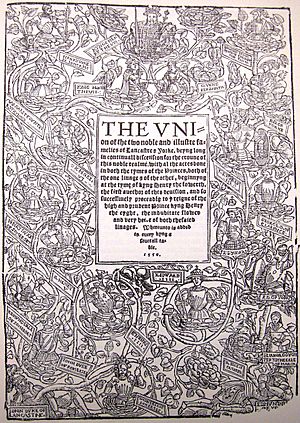Edward Hall facts for kids
Quick facts for kids
Edward Hall
|
|
|---|---|
| Member of Parliament for Bridgnorth | |
| In office 16 January 1542 – 31 January 1547 |
|
| Common Serjeant of London | |
| In office 17 March 1533 – 2 June 1535 |
|
| Preceded by | John Onley |
| Succeeded by | Sir Robert Southwell |
| Personal details | |
| Born | Unknown date, c. 1496 Poultry, London, England |
| Died | c. May 1547 (aged 50–51) London, Middlesex, England |
| Resting place | St Benet Sherehog, London |
| Parents | John Hall, Katherine Geddyng |
| Education | Eton College; King's College |
| Occupation | Lawyer, historian, politician |
| Inn of Court | Hon. Society of Gray's Inn |
| Notable work | Hall's Chronicle (1548) |
Edward Hall (born around 1496 – died around May 1547) was an English lawyer and historian. He is most famous for his book, The Union of the Two Noble and Illustre Families of Lancastre and Yorke. This book is usually called Hall's Chronicle. It was first published in 1548, after he died. Edward Hall was also a Member of Parliament several times. This means he was elected to help make laws for England.
Contents
Edward Hall's Family
Edward Hall was born in 1497. His father was John Hall, who passed away in 1528. John Hall was a grocer and a Merchant of the Staple in London. The Hall family had been London merchants for many years. Edward's father was even a leader in the Grocers' Company in 1512.
Edward's mother was Katherine Geddyng. She was buried in 1557 in a church called St Benet Sherehog. Edward had a brother named William. William was still alive when Edward passed away.
Did Edward Hall Marry?
We don't know if Edward Hall ever got married or had children. His will, which is like a last testament, was written in 1546 or 1547. It only mentions his brother, William, and his mother. He asked to be buried in a place called the Greyfriars, London. However, he was actually buried in the church of St Benet Sherehog. This church was later destroyed in the Great Fire of London.
In his will, Edward left all his books to his brother, William. He also left the handwritten copy of his famous history book to Richard Grafton. He trusted Grafton to publish it.
Edward Hall's Career
Edward Hall started his education at Eton College. This is a very famous school. In 1514, he went to King's College, Cambridge, a well-known university. He finished his studies there in 1518.
Edward became a lawyer and studied at Gray's Inn. He was a lawyer by 1521. He also held important positions there, like "Autumn Reader" in 1533.
Edward Hall was elected to Parliament several times. He represented different towns. He was elected for Much Wenlock in 1529 and again in 1539. Later, he was elected for Bridgnorth in 1542 and 1545. He also served as the Common Serjeant of London from 1533 to 1535. After that, he was an Under-Sheriff until he died.
Hall's Famous Book: The Chronicle

Edward Hall's most famous work is The Union of the Two Noble and Illustre Families of Lancastre and Yorke. Most people just call it Hall's Chronicle. It was published by a printer named Richard Grafton in 1548. This was the year after Edward Hall passed away. A new version came out in 1550. Grafton added more to the book from Hall's notes, continuing the story from 1532.
The Chronicle starts its story in 1399. This is when Henry IV became King of England. It then tells about the Wars of the Roses. This was a big fight between two important families, the Lancasters and the Yorks. With Grafton's additions, the book continues up to the death of Henry VIII in 1547.
Edward Hall wrote about King Henry VIII in a very positive way. He also showed that he supported the Protestants. Because he was a lawyer, he liked to describe ceremonies and important events in great detail.
The early parts of the Chronicle are not as important for historians. But the parts about Henry VII and Henry VIII are very valuable. The book gives us information from someone who lived during those times. It also helped inspire William Shakespeare when he wrote his famous history plays.
In 1940, a book dealer found a copy of Hall's Chronicle with many notes written in the margins. He thought these notes might have been made by William Shakespeare himself. This special book is now kept at the British Library.
Images for kids
-
The 1550 edition of Hall's Union of the Two Noble and Illustre Families of Lancastre and Yorke. It shows how Henry VIII was related to important historical figures.


